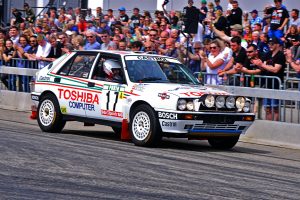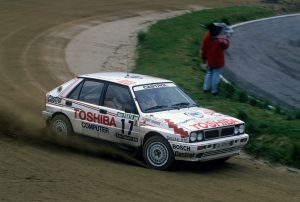Heute: Carsten Lock, Deutschland
Im Jahre 2015 wurde dieser Lancia dann von der Karlhofer OG erworben und in deren Werkstatt in Bärnbach in Österreich eingelagert. Mitte Juli 2019 hat Carsten Lock das Auto erworben. Danach wurde es von der Karlhofer OG in alle Einzelteile zerlegt und komplett neu aufgebaut. Während der Aufbauphase wurde akribisch darauf geachtet, dass das Auto wieder im originalen Zustand erstrahlt. Ein technisch versierter Fachmann wird erkennen, dass die Technik des 16V (Motor, Getriebe, Fahrwerk, Verkabelung, Bordcomputer etc.) dem Entwicklungsstand der frühen 90er Jahre entspricht. Im Zuge des umfassenden Neuaufbaus wurden die damals verbaute Löschanlage, die Sportsitze inklusive der Gurte und der Tank durch moderne, der FIA entsprechende Neuteile ersetzt. Das aktuelle Design entspricht der Beklebung, wie sie bei der Portugal Rallye 1991 zu sehen war.
Gestern: Ernst Harrach/Michael Uhl, Portugal Rallye 1991
Die Geschichte dieses Lancia Delta HF Integrale 16V begann 1987 bei Abarth in Turin. Der Servicetechniker des damaligen Lancia Rallye Teams Austria, Gerhard Karlhofer, holte die Karosserie und den geschraubten Überrollkäfig dort ab. In Voitsberg in Österreich wurde das Auto dann zu einem 4WD mit einem 8V-Motor aufgebaut. Bereits im Jahre 1986 formierte sich das Lancia Rallye Team Austria um den erfolgreichen österreichischen Rallyefahrer Franz Wittmann, der 1987 den WM-Lauf in Neuseeland mit einem Lancia Delta HF 4WD (dem Schwesterauto des jetzigen 16V) gewinnen konnte. Von 1987 bis etwa 1990 gehörte das Auto also zum Fuhrpark von Franz Wittmann. In dieser Zeit wurde das Fahrzeug vom schmalen 4WD zum breiten Integrale und schließlich auf 16V-Technik umgerüstet. Der zweite Evolutionsschritt betraf nicht nur den Motor, sondern auch andere Komponenten, wie beispielsweise das Getriebe und die Elektronik. Im Jahr 1990 gingen alle damaligen Wittmann Fahrzeuge inklusive dieses Integrales an den neuen Besitzer und österreichischen Rallyefahrer Ernst Georg von Harrach über. Dieser fuhr ihn im Jahre 1990 bei einigen Läufen zur österreichischen Staatsmeisterschaften und 1991 bei den WRC-Läufen Portugal und Argentinien und der Rallye Costa Smeralda. Von 1993 bis 1999 wurde das Fahrzeug nur noch sporadisch bei kleinen nationalen Rallyes von Ernst Harrach gefahren, bevor es dann für eine lange Zeit (ca. 16 Jahre) nicht mehr bewegt wurde.
Today: Carsten Lock, Germany
In 2015, this Lancia was acquired by the Karlhofer OG and stored in their workshop in Bärnbach in Austria. Carsten Lock acquired the car in mid-July 2019. It was then dismantled into all its individual parts by Karlhofer OG and completely rebuilt. During the rebuilding phase, meticulous care was taken to restore the car to its original condition. A technically experienced expert will recognise that the technology of the 16V (engine, gearbox, chassis, wiring, computer etc.) corresponds to the state of development of the early 90s. In the course of the comprehensive rebuild, the extinguishing system installed at that time, the sports seats including the seat belts and the tank were replaced by modern new parts that comply with the FIA. The current design corresponds to the livery as seen at the 1991 Portugal Rally.
Yesterday: Ernst Harrach/Michael Uhl, Portugal Rally 1991
The story of this Lancia Delta HF Integrale 16V began in 1987 at Abarth in Turin. The service technician of the then Lancia Rally Team Austria, Gerhard Karlhofer, picked up the bodyshell and the roll cage. In Voitsberg in Austria, the car was then built up into a 4WD with an 8V engine. As early as 1986, the Lancia Rally Team Austria was formed around the successful Austrian rally driver Franz Wittmann, who won the WRC round in New Zealand in 1987 with a Lancia Delta HF 4WD (the sister car of the current 16V). So, from 1987 to about 1990, the car was part of Franz Wittmann’s fleet. During this time, it was converted from a narrow 4WD to a wide Integrale and finally to 16V technology. The second evolutionary step affected not only the engine, but also other components, such as the gearbox and the electronics. In 1990, all Wittmann vehicles of the time, including this Integrale, passed to the new owner and Austrian rally driver Ernst Georg von Harrach. In 1990, he drove it in several rounds of the Austrian National Championship and in 1991 in the WRC rounds of in Portugal and Argentina as well as the Rally Costa Smeralda. From 1993 to 1999, the Lancia was only sporadically driven by Ernst Harrach in small national events, before it was not used again for a long time of approx. 16 years.
Aujourd’hui : Carsten Lock, Allemagne
En 2015, cette Lancia a été acquise par Karlhofer OG et stockée dans leur atelier de Bärnbach en Autriche. Carsten Lock a acquis la voiture à la mi-juillet 2019. Elle a ensuite été démontée entièrement par Karlhofer OG et entièrement reconstruite. Pendant la phase de reconstruction, un soin méticuleux a été apporté à la restauration de la voiture dans son état d’origine. Un expert techniquement expérimenté reconnaîtra que la technologie de la 16V (moteur, boîte de vitesses, châssis, câblage, ordinateur, etc.) correspond à l’état de développement du début des années 90. Au cours de la reconstruction complète, le système d’extinction installé à l’époque, les sièges sport, y compris les ceintures de sécurité, et le réservoir ont été remplacés par de nouvelles pièces modernes conformes aux normes FIA. Le design actuel correspond à décoration du Rallye du Portugal 1991.
Hier : Ernst Harrach/Michael Uhl, Rallye du Portugal 1991
L’histoire de cette Lancia Delta HF Intégrale 16V a commencé en 1987 chez Abarth à Turin. Le technicien chez Lancia Rally Team Austria de l’époque, Gerhard Karlhofer, a récupéré la carrosserie et l’arceau de sécurité. À Voitsberg, en Autriche, la voiture a ensuite été transformée en quatre roues motrices avec un moteur 8V. Dès 1986, le Lancia Rally Team Austria a été formé autour du pilote de rallye autrichien à succès Franz Wittmann, qui a remporté la manche WRC de Nouvelle-Zélande en 1987 avec une Lancia Delta HF 4WD (la voiture sœur de l’actuelle 16V). De 1987 à 1990 environ, la voiture a donc fait partie de la flotte de Franz Wittmann. Au cours de cette période, elle a été convertie d’une 4WD étroite à une Intégrale large et finalement à la technologie 16V. La deuxième étape de l’évolution a touché non seulement le moteur, mais aussi d’autres composants, tels que la boîte de vitesses et l’électronique. En 1990, tous les véhicules Wittmann de l’époque, y compris cette Intégrale, sont passés aux mains de leur nouveau propriétaire, le pilote de rallye autrichien Ernst Georg von Harrach. En 1990, il l’a pilotée sur plusieurs manches du championnat national autrichien et en 1991 sur les manches WRC du Portugal et de l’Argentine ainsi qu’au Rallye Costa Smeralda. De 1993 à 1999, la Lancia n’a été pilotée que sporadiquement par Ernst Harrach dans de petites épreuves nationales, avant de ne plus être utilisée pendant une longue période d’environ 16 ans.






